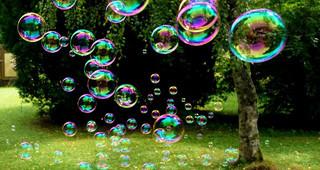
The surface layer of liquids has a thin elastic “skin” called surface tension. You can see surface tension at work when you see a drop of water – it creates a little “bead” of water, like a little dome. Surface tension is what makes the dome shape – the water doesn’t flatten out. Look for surface tension at work when you play with bubbles.
Water is made up of two kinds of atoms, hydrogen and oxygen. The name for the water molecule is H20. The water molecule has 2 hydrogen atoms and 1 oxygen atom. Water molecules are attracted to each other because hydrogen atoms and oxygen atoms are attracted to each other and hug close together really tight. This is called cohesion. The molecules hug so close together they don’t want to touch other molecules around them. That’s why a bubble is round and only rests a small part of itself on a surface when it lands.
Molecules and Bubbles
When you blow air into soap bubble solution the liquid molecules want to attract to each other again so they wrap around the burst of air until they can attach to each other again – this is what makes the round bubble shape. The air inside the solution is pushing the molecules in the soap bubble solution apart but the attraction between the soap bubble solution molecules is so great, the bubble doesn’t pop – the molecules are hugging each other too tight.
To experiment with bubbles you need a good bubble recipe. Below are some simple recipes to try. Each of the recipes use water and dish soap. The “other” ingredient can be baking powder, corn syrup, glycerin (sold at the pharmacy) or sugar. We had the best luck with baking powder. The baking powder recipe made some HUGE bubbles.
Science Project Idea:
Mix different formulas of bubble mix and test them to see which one makes the best bubbles. Use the same amount of water and the same amount of dish soap in at least three different buckets. Choose one “Other” ingredient and add it in different amounts to each of your trial buckets. To be fair, you should hold the bubble wand in front of a fan instead of trying to blow on it, that way you know that the amount of air being blown to make the bubble will be exactly the same. Test the three formulas several times and record your results on a chart. Decide before you begin what property you are looking for in the bubbles. Are you going to test which formula makes the biggest bubble, the bubble that lasts the longest without popping or the formula that makes the most bubbles?
Use your indyPL Library Card to check out books at any of our locations, or check out e-books and e-audiobooks from home right to your device. Need help? Call or ask a Library staff member at any of our locations or text a librarian at 317 333-6877.
Websites, Activities & Printables:
- Exploratoriuam: Bubbles
- Bubblesphere
- Exploratorium: Sticky Water
- USGS Water Science School: Surface Tension
- Video: NASA STEMonstrations – Surface Tension
- Video Khan Academy: Surface Tension

You can also ask a math and science expert for homework help by calling the Ask Rose Homework Hotline. They provide FREE math and science homework help to Indiana students in grades 6-12.
e-Books and Audiobooks
Use your indyPL Library Card to check out books about Science Experiments at any of our locations, or check out science experiment e-books and audiobooks from OverDrive Kids right to your device! If you have never used OverDrive before, you can learn how to use it for both e-books and audiobooks.
Need more help? Ask a Library staff member at any of our locations or call, text or email Ask-a-Librarian. Additionally, the Tinker Station helpline at (317) 275-4500 is also available. It is staffed by device experts who can answer questions about how to read, watch and listen on a PC, tablet or phone.
Surface Tension Projects from Bubbles to Sand Castles
What do bubbles and sand castles have in common? Surface tension! Learn about the amazing science of water and how it makes both bubbles and sand castles “stick”.
